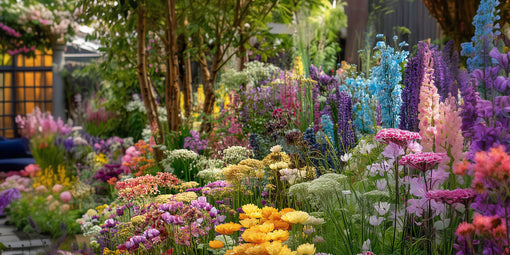
- Article published at:
Drawer menu

Hey there, fellow nature enthusiasts and sunflower lovers! It's august and what is the one flower you come to think about during this summer month? The sunflower..
There's something truly magical about these golden wonders that never fails to brighten our days (even these gloomy and rainy summer days we've had this year). So, buckle up as we embark on a journey into the radiant world of sunflowers – those cheerful blooms that seem to have a direct line to the sun itself.
The sunflower has long held the top spot as the most commonly grown cut flower worldwide, and it's no wonder - they are ridiculously easy to grow, and they thrive during the hottest days of summer and early autumn.
On top of this, they require very little attention to thrive. In this post, we'll walk you through what to think about when growing your own sunflowers - as well as some history and fun facts.

Now that we've marvelled at their stunning appearance, let's journey back through time and explore the historical and cultural tapestry that sunflowers have woven.
These golden blooms aren't just any flowers; they have deep roots in the rich soil of the Americas. Indigenous cultures revered sunflowers for their practical and spiritual significance, recognising their ability to provide sustenance and their role in ancient ceremonies. Along the way, these flowers have carried profound symbolism, embodying qualities ranging from devotion and loyalty to vitality and endurance.
The sunflower has been with us since 3000 BCE when it was first cultivated in North America. They were originally developed for food, medicine, dye and oil. It wasn't until around 1500 that the sunflower was exported to the rest of the world by Spanish conquistadors.
Let's start by taking a close-up look at these natural wonders that never fail to capture our attention – sunflowers! Standing tall and proud, sunflowers are like nature's exclamation mark, proclaiming their presence with an undeniable flair.
Imagine gazing upon a field of sunflowers, their stems reaching for the sky like enthusiastic sunseekers, and their flower heads beaming with the brilliance of a thousand suns. And those petals – oh, those petals! Radiant yellow hues that seem to capture the very essence of sunshine itself.
These iconic flowers come in an array of sizes and shapes, from the classic sunflower with a single colossal flower head to the charming varieties that flaunt multiple blooms.
Sunflowers display a behaviour called heliotropism, which means that they track the sun. The young blossoms will face east in the morning, and follow the sun as the Earth moves during the day.
Giant sunflowers reach a height of up to 12 feet or more. The world's tallest sunflower reaches 30 feet and 1 inch.
In 2012, the astronaut, Don Pettit, brought along some sunflower seeds up to space and planted them at the International Space Station.
Each sunflower can contain as many as 1000 to 2000 seeds.
There are about 70 different species of sunflowers.
Sunflowers are good at absorbing toxins, and they have been planted in Fukushima, Japan, to soak up nuclear radiation after the devastating tsunami.


There are two different types of sunflowers; branching and non-branching. Branching types get quite large and produce a lot of blooms over a long period of time. They need a lot of room, and should be spaced about 18 to 24 inches apart.
Non-branching types (also called single stem) produce one flower per seed, and are the types that most florists will keep in stock. For smaller, bouquet sized blooms, space plants 4 to 6 inches apart.
Sunflowers need a lot of sun. The ideal location is one which provides 6-8 hours of sun a day in a sheltered location so there's low risk of wind or storm damage. The soil should be rich and well trained, and free from rocks or other large roots. Any obstacles in the soil will inhibit root and plant growth.
Harvest as soon as the first petals on the sunflower blooms start to unfurl, and strip the bottom three quarters of the leaves from the stem, for the longest vase life. No flower preservative is needed.
And there you have it, fellow sunflower enthusiasts – a deep dive into the radiant world of sunflowers that has left us utterly captivated and brimming with newfound admiration.
From their towering stems that defy gravity to their golden petals that mimic the sun's warm embrace, sunflowers have unveiled a symphony of nature's beauty that never fails to leave us in awe.
So, as we bid farewell to the wonderful world of sunflowers, let's remember to carry a piece of their brilliance with us. Let's keep our faces turned towards the sun, just like these magnificent blooms do, and let their radiant warmth light our path forward.